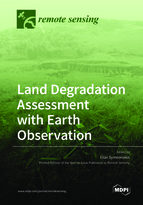Land Degradation Assessment with Earth Observation
A special issue of Remote Sensing (ISSN 2072-4292). This special issue belongs to the section "Environmental Remote Sensing".
Deadline for manuscript submissions: closed (30 June 2021) | Viewed by 71018
Special Issue Editor
Interests: remote sensing; land degradation; AI algorithms
Special Issues, Collections and Topics in MDPI journals
Special Issue Information
Dear Colleagues,
For decades now, land degradation has been identified as one of the most pressing problems facing the planet. Alarming estimates are often published by the academic community and intergovernmental organisations, claiming that a third of the planet is undergoing various degradation processes and almost half of the world’s population is already residing in degraded lands. Moreover, as land degradation directly affects vegetation biophysical processes and leads to changes in ecosystem functioning, it has a knock-on effect on habitats and, therefore, on numerous species of flora and fauna that become endangered or/and extinct.
The processes that have more commonly been identified as the driving factors behind land degradation are both anthropogenic as well as climatic, and numerous studies have thus far attempted to disentangle the nexus between the two. Most prominent causes have appeared to be the processes of soil erosion by water or wind, soil salinization, gully erosion, natural hazards, land use/cover change, agricultural expansion or abandonment, deforestation, urbanisation, grazing intensification, bush encroachment, fuelwood extraction and drought.
By far the most widely used approach in assessing land degradation has been to employ Earth observation data. Especially during the last decade, with technological advancements and the computational capacity of computers on the one hand, together with the availability of open-access remotely-sensed data archives on the other, numerous studies dedicated in the study of the various aspects of land degradation have been undertaken. The spectral, spatial and temporal resolution of these studies varies considerably, and multiscale, multitemporal and multisensor approaches have also evolved.
This forthcoming Special Issue on “Land Degradation Assessment with Earth Observation” calls for original research papers with a focus on land degradation in arid, semiarid and dry-subhumid areas (i.e., desertification), but also temperate rangelands, grasslands, woodlands, peatlands and the humid tropics. Papers covering any spatial and temporal scale are welcome, and both abrupt and more salient changes and degradation processes are of interest. Time–series analysis techniques that assess the timing and duration of the reduction in biological productivity brought about by land degradation are also encouraged.
Dr. Elias Symeonakis
Guest Editor
Manuscript Submission Information
Manuscripts should be submitted online at www.mdpi.com by registering and logging in to this website. Once you are registered, click here to go to the submission form. Manuscripts can be submitted until the deadline. All submissions that pass pre-check are peer-reviewed. Accepted papers will be published continuously in the journal (as soon as accepted) and will be listed together on the special issue website. Research articles, review articles as well as short communications are invited. For planned papers, a title and short abstract (about 100 words) can be sent to the Editorial Office for announcement on this website.
Submitted manuscripts should not have been published previously, nor be under consideration for publication elsewhere (except conference proceedings papers). All manuscripts are thoroughly refereed through a single-blind peer-review process. A guide for authors and other relevant information for submission of manuscripts is available on the Instructions for Authors page. Remote Sensing is an international peer-reviewed open access semimonthly journal published by MDPI.
Please visit the Instructions for Authors page before submitting a manuscript. The Article Processing Charge (APC) for publication in this open access journal is 2700 CHF (Swiss Francs). Submitted papers should be well formatted and use good English. Authors may use MDPI's English editing service prior to publication or during author revisions.
Keywords
- Land degradation
- Desertification
- Deforestation
- Drought
- Soil erosion
- Land use/cover change
- Habitat degradation
- Multitemporal analysis
- Time–series analysis






